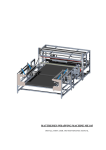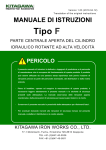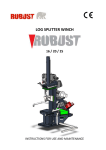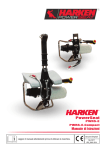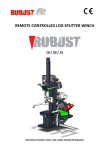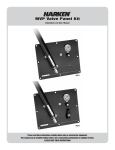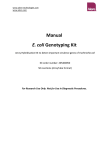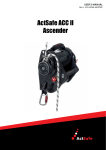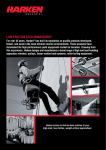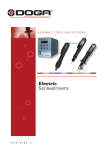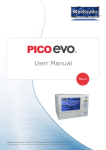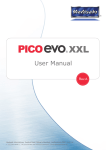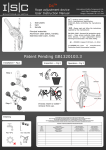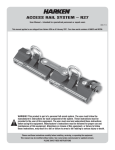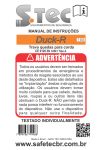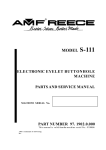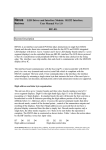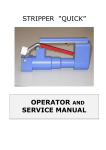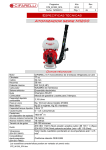Download PowerSeat Instruction Manual
Transcript
PowerSeat PWRS-G Instruction Manual English Translation Please read these instructions carefully before operating equipment. Rev.: UPS_02/05-2012 Table of Contents Introduction page 4 About this Manual page 4 Glossary and Symbols page 5 page 6 Identification Data and Plates on the Device page 6 Declaration of Conformity page 7 Standard References page 8 Technical Support Information page 8 page 9 General Advice page 9 Intended Use page 9 Improper Use page 10 Safety Devices page 10 Personal Protective Equipment(PPE) page 10 Residual Risks page 10 page 11 General page 11 Dimensions page 12 Safe Working Load page 13 Rope Requirements page 13 Vibration page 13 Noise Emission page 13 page 14 page 14 page 15 Checking the Device Before Use page 15 Primary Rope Installation Procedure page 16 Preparing to Ascend page 19 Ascent Procedure 1 page 20 Ascent Procedure 2 page 21 General Information Safety Precautions Device Description Technical Data Engine Using the Device 2 ENGLISH 05-09-12 Table of Contents Using PowerSeat with a Fixed Anchorage page 22 Descent Procedure 1 page 22 Descent Procedure 2 page 25 Fixed Anchorage Descent procedure page 25 Refueling page 26 Transport and Storage page 26 page 26 Cleaning page 26 Maintenance page 26 Engine Maintenance page 26 Dismantling and Disposal page 26 Diagnosis and Fault Finding page 27 Maintenance Schedule page 27 Worldwide Limited Warranty page 30 Maintenance 05-09-12 ENGLISH 3 Introduction ABOUT THIS MANUAL This User Manual is an integral part of the device and aims to provide all the information needed for its safe and correct use and for proper maintenance. If there are instructions you do not understand, contact Harken. Keep the manual in a safe place for future consultation. This manual may be modified without notice. Updated versions are available on www.power-seat.com. This manual is for qualified operators (refer to the Safety Information chapter for more information). Improper use of the device or incorrect maintenance could cause severe damage or death. Harken accepts no responsibility for damage, personal injury or death caused by failure to observe the safety information and instructions in this Manual. The device must be used exclusively by qualified operators in possession of a certificate for temporary work at height with the use of access and positioning systems using ropes according to the current regulations of the Nation in which the device is used. This manual thus supplies information exclusively regarding the correct use of the device and does not substitute the training and certification needed for temporary work at height with the use of access and positioning systems using ropes. 4 ENGLISH 05-09-12 Introduction GLOSSARY AND SYMBOLS Intended Use – use of the device according to the information supplied in the instructions for use. Improper Use – use of the device in a way different from that indicated in the instructions for use. Qualified Operator – persons who have attended specialisation, training etc courses and are certified for temporary work at height with the use of access and positioning systems using ropes according to the current regulations of the Nation in which the device is used. User - qualified operator of the device Anchorage – point of attachment of the rope or device to a fixed point. Primary (working) rope – main rope used for ascending or descending using the device (approved according to EN 1891). Secondary (backup) rope – safety rope to protect the operator from falling if the primary rope breaks (approved according to EN 1891). Fall arrest – individual protection device that brakes the fall of the user (EN353/2 approved). Text preceded by the following symbols contains very important information or instructions, especially in regards to safety. Failure to observe these may lead to: danger for operators invalidity of the contract warranty refusal of the manufacturer to accept responsibility WARNING! this denotes the existence of the potential danger, which could cause injury or damage if the information or instructions are not followed NOTE! this denotes important information concerning the device 05-09-12 ENGLISH 5 General Information IDENTIFICATION DATA AND PLATES ON THE DEVICE Each device is identified by a CE plate on which the reference data of the device are inscribed indelibly. Always quote these references when contacting the manufacturer or service centres. PowerSeat via Marco Biagi, 14 22070, Limido Comasco (CO) - Italy www.harken.com (+39) 031 3523511 L PWRS-G Serial No. / N. di serie Year / Anno 2012 2006/42/EC rope diameter diametro fune ø 10-12,7 mm EN1891 Safe Working Load (SWL) 273 kg 1 3 2 4 5 6 7 8 1. name of manufacturer 2. name of product and model 3. manufacturer's identification data 4. CE mark according to 2006/42/CE 5. year of manufacture 6. serial number in the format: S XXXXX XXXXXXXXX last two numbers of the year of manufacture of the device (e.g. 12 = the year 2012) 7. pictogram instructing you to read the manual before using the device 8. safety instruction on the diameter of the rope to use: minimum 10 mm, maximum 12.7 mm: this rope must be EN 1891 certified, plus indication of the Safe Working Load (SWL) of the device The CE plate is on the chassis of the device: L 2012 Year / Anno Serial No. / N. di serie PWRS-G ENGLISH PowerSeat 2006/42/EC rope diameter ø 10-12,7 mm EN1891 diametro fune Safe Working Load (SWL) 273 kg via Marco Biagi, 14 22070, Limido Comasco (CO) - Italy www.harken.com (+39) 031 3523511 6 05-09-12 General Information DECLARATION OF CONFORMITY DECLARATION OF EC COMPLIANCE 1. (All. IIA Dir. 2006/42/CE) The undersigned Harken Italy S.p.A. Via Marco Biagi, 14, 22070 Limido Comasco (CO) Italy Telephone: +39 031/3523511, Fax: +39 031/3520031 Email: [email protected], Web: www.harken.it hereby declares that the machine: LIFTING SYSTEM OF PEOPLE AND THINGS BY USING TECHNICAL ROPES Model POWERSEAT PWRS-G Serial Nr. Year of Manufacture 2012 complies with the essential requirements defined by the following directives: Directive 2006/42/CE of the European Parliament and Council of 17th May 2006 concerning "machines" amending directive 95/16/CE; Regulations reference: UNI EN ISO 12100:2010 and authorises Name and Surname: Andrea Merello Address: HARKEN ITALY S.p.A. Via Marco Biagi, 14 Post code: 22070 City: Limido Comasco Country: Italy Province: Como to carry out the technical file for it Certification services: Bureau Veritas Italia SpA. Certification Nr.: 1370-160R-IX-0002-24-2012 Date of issue: May/2012 Limido Comasco, lì 05/02/2012 05-09-12 HARKEN ITALY S.p.A. Legal representative ENGLISH 7 General Information STANDARD REFERENCES The device has been manufactured in conformity with the TECHNICAL REGULATIONS listed below: Reference technical standards UNI EN ISO 12100:2010 Safety of machinery -- General principles for design -- Risk assessment and risk reduction UNI EN ISO13857:2008 Safety of machinery -- Safety distances to prevent hazard zones being reached by upper and lower limbs UNI EN 349:2008 Safety of machinery - Minimum gaps to avoid crushing of parts of the human body UNI EN 1037:2008 Safety of machinery - Prevention of unexpected start-up EN ISO 13849-1:2008 Safety of machinery – Safety-related parts of control systems – Part 1: General principles for design EN ISO 13849-2:2008 Safety of machinery – Safety-related parts of control systems – Part 2: Validation UNI EN ISO 13732-1:2007 Ergonomics of the thermal environment - Methods for the assessment of human responses to contact with surfaces - Part 1: Hot surfaces UNI EN 614-1:2006 Safety of machinery - Ergonomic design principles - Part 1: Terminology and general principles UNI EN 614-2:2006 Specification and qualification of welding procedures for metallic materials - Welding procedure test - Part 2: Arc welding of aluminium and its alloys UNI EN 953:2009 Safety of machinery - Guards - General requirements for the design and construction of fixed and movable guards UNI EN 1005-1:2009 Safety of machinery - Human physical performance - Part 1: Terms and definitions UNI EN 1005-3:2009 Safety of machinery - Human physical performance - Part 3: Recommended force limits for machinery operation UNI EN 1005-4:2009 Safety of machinery - Human physical performance - Part 4: Evaluation of working postures and movements in relation to machinery UNI EN ISO 3746:2011 Acoustics - Determination of sound power levels and sound energy levels of noise sources using sound pressure - Survey method using an enveloping measurement surface over a reflecting plane UNI EN ISO 11204:2010 Acoustics -- Noise emitted by machinery and equipment -- Determination of emission sound pressure levels at a work station and at other specified positions applying accurate environmental corrections UNI EN ISO 4871:2009 Acoustics - Declaration and verification of noise emission values of machinery and equipment UNI EN ISO 11806:2009 Agricultural and forestry machinery - Portable hand-held combustion engine driven brush cutters and grass trimmers - Safety UNI EN ISO 7000:2012 Graphical symbols for use on equipment -- Registered symbols TECHNICAL SUPPORT INFORMATION The PowerSeat is covered by a warranty, as laid down in the general conditions of sale. If during the warranty period the device proves defective or suffers breakages, as indicated in the warranty, the manufacturer, after checking the device, will repair or replace the defective components. You are reminded that modifications carried out by the user, without explicit written authorisation from the manufacturer, will invalidate the warranty and relieve the manufacturer of any responsibility for damage caused by the defective product. The same considerations apply when spare parts that are not original or different from those explicitly indicated by the manufacturer as “safety devices” are used. For all these reasons we advise customers to contact Harken Technical Support. 8 ENGLISH 05-09-12 Safety Precautions GENERAL ADVICE WARNING! read the instructions in this manual attentively and carefully follow the indications it contains before using the PowerSeat Use of the PowerSeat is restricted to qualified operators who are certified for temporary work at height with the use of access and positioning systems using ropes according to the current regulations of the Nation in which the device is used. Harken is not responsible for damage caused by the PowerSeat to people, animals or property in the case of: - use of the PowerSeat by operators without proper certification. - improper use of the PowerSeat - lack of proper maintenance, as indicated in the Maintenance chapter of this Manual - unauthorised modifications or changes - use of spare parts that are not original or specific for the model - total or partial failure to observe the instructions - usage contrary to specific national regulations For safety information on the use of the engine, consult the Engine Manual supplied together with this Manual INTENDED USE The PowerSeat is designed to help qualified operators ascend a rope using the engine and descend using a passive manual device. The PowerSeat is not safety equipment and is not a Personal Protective Equipment. It must always be used in combination with a secondary rope to which is connected the fall arrest device fixed to the operator’s harness by a cord with an energy absorber, and must satisfy the requirements of EN 363 on individual systems for the protection against falling from heights. Use the PowerSeat only in sufficiently ventilated areas, as the engine exhaust gases contain carbon monoxide. In order to use the PowerSeat a risk analysis, and rescue plan must have been drawn up, as required by current regulations of the nation where the device is used on temporary work at height and the use of access and positioning systems using ropes. The following guidelines must also be considered: - IRATA: International Code of Practice. - C(HSW)R: The Construction (Health, Safety and Welfare) Regulations. - LOLER: The Lifting Operations and Lifting Equipment Regulations. - MHSWR: The Management of Health and Safety at Work Regulations. - PUWER: The Provision and Use of Work Equipment Regulations This list is not complete and it is the responsibility of the qualified operator to be aware of current regulations in his country on temporary work at height and the use of access and positioning systems using ropes or other regulations relating to his specific sector of work. 05-09-12 ENGLISH 9 Safety Precautions IMPROPER USE The machine must not be used: - for purposes different from those outlined in “Intended use” chapter, or for purposes not mentioned in this manual or different from those mentioned - if unauthorised modifications or interventions have been carried out - in an explosive atmosphere - after it has fallen from a height of more than 1mtr onto a hard surface. In this case the device must be returned to the manufacturer or to a Harken authorised repair centre. SAFETY DEVICES The following safety devices are installed: - Fall arrest attachment consists of strap and carabiner locked to the main support plate certified according to EN 1275; EN 362 Standards. - Plastic cover on the central support for protecting the device from contact shocks and rope jamming - Shaped plastic guard between the descending knob and the rope entry on the winch to prevent the rope jamming and tangling. PERSONAL PROTECTIVE EQUIPMENT (PPE) The device bears an adhesive label reminding you of the obligation: - to use gloves - to use ear plugs or ear muffs RESIDUAL RISKS You must pay attention to the following residual risks present when using PowerSeat: WARNING! Rotating Parts Trapping Risk Always wear clothing and protective gloves that are form fitting. Avoid loose gloves or clothing and always follow the instructions in the manual WARNING! Noise Risk Always wear suitable ear protection and always follow the instructions of the manual WARNING! Vibration Risk Always wear suitable protection and always follow the instructions of the manual WARNING! Risk of Falling Always use personal protective equipment and always follow the instructions of the manual 10 ENGLISH 05-09-12 Device Description GENERAL The PowerSeat is designed to help qualified operators ascend a rope and descend using a passive manual device. The rope must be inserted in its housing in the vertical tube, through the deflector sheave, wrapped round the winch drum and locked in the rope grab. When the engine is started, a transmission system rotates the drum and creates a traction force on the rope. The engine is 4-stroke internal combustion and supplies the power for ascending, it has a pull start with automatic rewind and double action mechanical controls. Switch off is electrical. During descent the engine is switched off and the operator uses the lever to open the rope grab and allow the rope to slide round the drum in a controlled descent. Pos. 05-09-12 Description Pos. Description 1 Seat 14 Fuel tank cap 2 Snap-hook 15 Protection 3 Strop 16 Front tube 4 Knob 17 Eyebolt 5 Cover 18 Pin 6 Rope grab 19 Engine 7 Stripper arm 20 Engine “start/stop” switch 8 Winch Drum 21 Accelerator engage lever 9 Reduction gear casing 22 Accelerator lever 10 Clamp 23 Accelerator control 11 Damper 24 Engine oil cap 12 Anchorage point 25 Frame 13 Front plate ENGLISH 11 Device Description (12.8") DIMENSIONS (18.5") (16.6") (16.4") (32.1") 12 ENGLISH 05-09-12 Device Description SAFE WORKING LOAD The Safe Working Load of the PowerSeat is 273 Kg (600 lb). WARNING! Do not apply a load greater than the Safe Working Load to the PowerSeat ROPE REQUIREMENTS WARNING! Use only EN1891 certified ropes with a diameter of between 10 - 12.7 mm (3/8" - 1/2") WARNING! Use only ropes in good condition WARNING! For correct maintenance of ropes consult the rope Usage Manual VIBRATION Values relate to 10 minute use time (the calculation has been performed using the highest value among three different test runs) Worker's Job Exposure action value (A(8) m/s2 ) Hand-arm (in/s2) Whole body (in/s2) 1,41 (55,5) <0,1 (<3,9) PowerSeat User (exposure calculated estimating a 10 minute use, required time for an ascend of approx 40 m (131ft)) NOISE EMISSION ACOUSTIC POWER LEVEL (LWA) (ACCORDING TO ISO 3746): 96.2 dB(A) AVERAGE SURFACE ACOUSTIC PRESSURE LEVEL (LpfA,d (medio)) (ACCORDING TO ISO 3746): LpfA,d (average) = 81.3 dB ACOUSTIC DATA MEASURED AT OPERATOR PLACE (ACCORDING ISO 11204) Uncertainty = 6 dB SEATING OPERATIVE MODE L’pA = 89.9 dB - C peak level at operator place: LpC,peak = 103.8 dB ASCENT PROCEDURE 2 L’pA = 100.9 dB - C peak level at operator place: LpC,peak = 116.8 dB 05-09-12 ENGLISH 13 Technical Data Below are the principal technical data of the PowerSeat obtained with a rope 11mm (7/16") in diameter at a temperature of 20°C at sea level. Rope Semi static 10mm-12.7mm (1/8"-1/2") EN1891 rope Safe Working Load 273 kg (600 lb) Maximum Load on Seat 150 kg (330.7 lb) Ascent speed 0-15 m/min (120 kg) (0-49 ft/min (264,5 lb)) 0-11 m/min (273 kg) (0-39 ft/min (600 lb)) Range 600m (273 kg load) (1968.5 lb (600 lb load)) Reduction Ratio 157,4:1 Weight when empty 14,5 kg (32 lb) Dimensions 815.5 x 471 x 325 mm (32.1" x 18.5" x 12.8") Recommended working temperature range -5°C +40°C (23 to 104 °F) (*) Recommended height range 0 m - 1500 m (0 ft - 4920 ft) (**) (*) The PowerSeat may be used at temperatures outside the recommended range, but performance will be different from that indicated above. For more information contact Harken. (**) The PowerSeat may be used at heights outside the recommended range, but performance will be different from that indicated above. For more information contact Harken. Engine Honda GX35 Type 4 stroke, overhead camshaft, single cylinder Capacity 35,8 cm3 (2.2 cu in) Maximum Torque 1,6 Nm (1.2 lb) at 5500 rpm Net Power 1 kW (1.3 hp) at 7000 rpm1 Weight when empty 3,46 kg (7.6 lb) Dimensions 205 x 234 x 240 mm (8.1" x 9.2" x 9.4") Engine oil capacity 0,10L (3.3 oz) Fuel tank capacity 0,63L (21.4 oz) Ignition system transistorised magneto Cooling system forced air Engine oil SAE 10W-30, API SJ or later, for general use Fuel lead free petrol of at least 86 octane at pump (RON octane number at least 91) ENGINE 14 ENGLISH 05-09-12 Using the Device CHECKING THE DEVICE BEFORE USE Before and after every use, visually inspect the PowerSeat for traces of wear, damage or breakage. If such traces are present, do not use the device. If the worn or defective parts are not immediately replaced, the manufacturer will assume no responsibility for resulting damage or accidents. In particular: 05-09-12 Check that the strop and carabiner are intact. Check the movement of the rope grab cover. Check that the rope grab knob is working by rotating it and releasing it (CLOSE JAW). Check that the rope grab knob is working by rotating it and releasing it (OPEN JAW). ENGLISH 15 Using the Device Inspect all screws and check that the marker on the screws and on the plate are aligned. In case of any misaligned contact a HARKEN service center. Verify the alignment of all screws and check that the winch is correctly fixed to the frame and the engine is correctly fixed to the reduction gear. NOTE! Before every use carry out a function check with the device unloaded to check for any problems with the engine. Rotate the winch drum clockwise by hand and make sure that it cannot rotate anticlockwise. PRIMARY ROPE INSTALLATION PROCEDURE 1. Place the PowerSeat on the ground. 16 2. Pull open the clamp and slide the front tube into the housing. ENGLISH 05-09-12 Using the Device WARNING! Slide the front tube correctly into its housing until the red reference mark is no longer visible 05-09-12 3. Pass the rope inside the pin. 4. Fit the rope into the front tube. 5. Pass the rope round the pulley. 6. Make sure the rope has been fitted correctly into its housing. ENGLISH 17 Using the Device WARNING! Take at least two turns of the rope around the winch drum, and if it slips under load increase the number of turns to a maximum of four, taking care not to overlap the rope 7. Wind the rope clockwise around the winch drum. NOTE! The number of turns needed round the winch drum depends on the load and the condition of the rope. Check the device's descending capacity in its working configuration. Before use ascend with the device, no more than 1 mtr (3,28 ft) and check, according to the descent procedure 1, that it's descending smoothly. In case of difficulties unwind the rope, and reduce the turns to not less than 2 wraps, until you have the optimal configuration. 18 8. Pass the rope over the stripper arm. 9. Fit the rope into the rope grab. Raise the cover to make this easier. 10. Position the rope inside the stopper. 11. Close the protective cover with the strap. ENGLISH 05-09-12 Using the Device PREPARING TO ASCEND Install two ropes, Primary and Secondary, with separate anchorage points. Each rope must support at least 15 kN. Install the Primary (or working) rope on the device as directed Primary Rope Installation Procedure above. Attach the Secondary (or backup) rope is attached to the operator using a fall arrest device (EN353/2 approved) and energy absorber (EN355 approved). Both ropes must be EN1891 Class A certified and have a diameter of between 10 (1/8" ) and 12.7 mm (1/2"). In the case of fault or breakage of the device or of the primary rope, the load will be immediately transferred to the secondary rope through the fall arrest device, thus constituting the anti-fall system. WARNING! Use the PowerSeat only with the primary and secondary ropes installed so as to create the anti-fall system described above To use the PowerSeat the operator must also wear: 1. A full EN 361 and EN813 certified harness to which the device is attached at the lower front attachment and the fall arrest device at the upper front attachment 2. An EN 795 B certified waist strop connected to the two side attachments of the harness and passing outside the front tube of the PowerSeat 3. Appropriate Individual Personal Protective Equipment (PPE) (e.g. helmet, gloves, protective glasses and ear plugs) 4. Suitable clothing, form fitting so it cannot catch on moving parts Pos. Description 1 primary rope 2 secondary rope 3 fall arrest device 4 upper front attachment 5 full harness 6 waist strop 7 lower front attachment 8 side attachment points 9 helmet 10 protective glasses 11 ear plugs 12 gloves WARNING! Do not use the PowerSeat in the case of illness, tiredness or if under the influence of drugs or alcohol WARNING! Keep your hands, feet and clothing etc away from the moving parts of the device WARNING! During the ascent some parts of the engine could heat up. Handle the device with care to avoid injury 05-09-12 ENGLISH 19 Using the Device For further information on the use of the engine consult the Engine Manual supplied together with this manual. ASCENT PROCEDURE 1 1. Install the primary rope on the device as indicated in the “Primary Rope Installation Procedure" paragraph 2. Sit on the device 3. Connect the fall arrest device to the harness as described in the “Preparing to Ascend” paragraph 4. Connect the waist strop to the two side attachment points of the harness, passing it outside the front tube of the PowerSeat. 5. Connect the snap-hook provided with the device to the lower front attachment point of the harness Fall Arrest Device Upper Front Attachment Lower Front Attachment Waist Strop Side Attachment Point 7. Pull the starter cord. 6. Place the accelerator control in the START position. 20 ENGLISH 05-09-12 Using the Device Upper lever Lower lever 8. Adjust the position of the accelerator control so it is ergonomically comfortable for the operator and away from the engine exhaust. To do this, loosen the fixing screw, position the accelerator control and retighten the fixing screw. 9. To ascend, fully press the upper red lever and at the same time adjust the speed by pressing the lower red lever. WARNING! Before using the device check that the rope is correctly installed ASCENT PROCEDURE 2 1. Install the primary rope on the device as indicated in the “Primary Rope Installation Procedure” paragraph 2. Start the device and position it at the height of the operator’s shoulders 3. Connect the fall arrest device to the harness as described in the “Preparing to Ascent” paragraph 4. Connect the snap-hook supplied with the device to the lower front attachment point of the harness In ascent procedure 2 the Waist strop is not used Lower Front Attachment to PowerSeat Upper front Attachment to Fall Arrest 5.Place the accelerator control in the START position and pull the starter cord. 05-09-12 ENGLISH 21 Using the Device 6. Adjust the position of the accelerator control so it is ergonomically comfortable for the operator and away from the engine exhaust. To do this, loosen the fixing screw, position the accelerator control and retighten the fixing screw. 7. To ascend, fully press the upper red lever and at the same time adjust the speed by pressing the lower red lever. WARNING! Before using the device check that the rope is correctly installed USING POWERSEAT WITH A FIXED POINT NOTE! To use the PowerSeat with a fixed point at least two operators are necessary. One operates the device and the second is connected by the primary rope to the device and to the secondary rope by the (EN353/2 approved) fall arrest device. Both ropes must be EN1891 certified and have a diameter of between 10 (1/8") and 12.7 mm (1/2"). The secondary rope must have an anchorage point that supports at least 15kN. The device is connected to a fixed anchorage point on the ground which must support at least 15kN 2. Unscrew the four screws that fix the seat to the chassis with a n°5 hex Key. 1. Pull the clamp and slide out the front tube. 3. Remove the seat. 22 ENGLISH 05-09-12 Using the Device 4. Install the primary rope on the device as indicated in the “Primary rope installation procedure” paragraph. In this case the primary rope will be used to lift the second operator. 5. Connect the anchorage point on the front plate of the device with the fixed anchorage point on the ground. 6. Place the accelerator control in the START position and pull the starter cord 7. Adjust the position of the accelerator control so it is ergonomically comfortable for the operator and away from the engine exhaust. To do this, loosen the fixing screw, position the accelerator control and retighten the fixing screw. 8. To operate the PowerSeat fully press the upper red lever and at the same time adjust the speed by pressing the lower red lever. WARNING! To use the PowerSeat in the fixed point configuration the primary rope under load must leave the winch with a lateral and frontal angle of between ± 6° WARNING! Before using the device check that the rope is correctly installed 05-09-12 ENGLISH 23 Using the Device DESCENT PROCEDURE 1 2. With one hand grasp the rope leaving the winch. 1. Switch off the engine by moving the accelerator control to the STOP position. NOTE! If the accelerator control does not work, stop the engine by shutting off the carburettor air intake, moving the air lever to the CLOSED position (see Engine Manual) 3. With the other hand, turn the knob clockwise to allow the rope to slip on the winch drum and permit a controlled descent. To adjust descent speed, manually control the speed at which the rope leaves the winch by holding rope with arm out and bringing it in towards the winch drum. To stop the descent, release the knob. To facilitate descent, a carabiner can be fixed to the ring on the front tube and the primary rope passed through it. NOTE! Take care not to overbalance when getting off the seat. Lower the PowerSeat until the operator's feet are firmly on the ground, but the unit is still suspended. Stand up and move on the seat. Now the device can be lowered to the ground and released from the rope. 24 ENGLISH 05-09-12 Using the Device DESCENT PROCEDURE 2 2. With one hand grasp the rope leaving the winch. 1. Switch off the engine by moving the accelerator control to the STOP position. NOTE! If the accelerator control does not work, stop the engine by shutting off the carburettor air intake, moving the air lever to the CLOSED position (see Engine Manual) 3. With the other hand, turn the knob clockwise to allow the rope to slip on the winch drum and permit a controlled descent. To adjust descent speed, manually control the speed at which the rope leaves the winch. To stop the descent, release the knob. FIXED ANCHORAGE DESCENT PROCEDURE 1. Switch off the engine by moving the accelerator control to the STOP position NOTE! If the accelerator control does not work, stop the engine by shutting off the carburettor air intake, moving the air lever to the CLOSED position (see Engine Manual) 2. With one hand grasp the rope leaving the winch. 3. With the other hand, turn the knob clockwise to allow the rope to slip on the winch drum and permit a controlled descent. To adjust descent speed, manually control the speed at which the rope leaves the winch. To stop the descent, release the knob. 05-09-12 ENGLISH 25 Using the Device REFUELING For refueling, consult the Engine Manual supplied together with this manual. TRANSPORT AND STORAGE Transport the device in the box supplied when it was purchased. For transport, empty the engine fuel tank. When not in use the device must be placed in its box to prevent it from knocks and shock, with the fuel tank empty. Protect the device from humidity and abrupt temperature change. Do not allow the device to come into contact with corrosive substances. Clean the device before storing. Maintenance CLEANING Regularly clean and dry the device with a damp cloth to remove accumulated dirt. Do not use a direct jet of water or a high pressure water jet cleaner. Do not use degreasing products, solvents or abrasive pastes. MAINTENANCE Before and after every use visually inspect the PowerSeat for traces of wear, damage or breakage. Refer to the “Checking the device before use” paragraph for more detail on this inspection. Once a year, return the device to the manufacturer or to an authorised Harken centre for a full service. This maintenance must be registered in the Maintenance Log. ENGINE MAINTENANCE For engine maintenance, consult the Engine Manual supplied together with this manual. Dismantling and Disposal When the device is dismantled, it is necessary to separate the parts in plastic, those in metal and electrical components, which must be sent to differentiated disposal centres in accordance with the regulations of the country where the device is dismantled. 26 ENGLISH 05-09-12 Diagnosis and Fault Finding Problem Possible Causes Possible Solutions The rope slips on the winch drum - too few turns around the winch drum - diameter of rope not in prescribed range - take another turn of the rope round the winch drum - replace the rope The engine does not start - incorrect starting procedure or engine fault - consult the Engine Manual Limited lifting capacity - engine malfunction - device used above 1500 m - consult the Engine Manual - contact Harken for more information Difficult descent - too many wraps on winch drum - unwind the rope, reducing wraps. Leave at least 2 wraps on winch drum - contact Harken for more information - rope grab system possible malfunction For more information on the correct working of the engine refer to the “Dealing with unexpected problems” paragraph in the Engine Manual. Maintenance Schedule Owner name Product name and Model Serial Number Engine Serial Number Year of manufacture Date of purchase Date of first use Maintenance interval 05-09-12 Annual ENGLISH 27 Maintenance Schedule Date of Service 28 Name and Signature of Maintanance Operator Description of Service ENGLISH Date of Next Intervention 05-09-12 05-09-12 ENGLISH 29 Manufacturer Harken Italy SpA. Via Marco Biagi 14, 22070 Limido Comasco (CO), Italy Tel 031.3523511; Fax 031.3520031 Web: www.harken.it Email: [email protected] EU Representative Harken UK Ltd Bearing House, Ampress Lane Lymington, Hampshire S041 8LW, England Telephone: (44) 01590-689122 • Fax: (44) 01590-610274 Web: www.harken.co.uk Email: [email protected] World Limited Warranty Refer to the Harken World Limited Warranty on the website at: http://www.power-seat.com/power_seat#contentdownloads The product warranty is accepted only if it has been maintained as specified in this Manual by Harken authorized personnel and is accompanied by Maintenance Schedule properly compiled 05-02-12






























